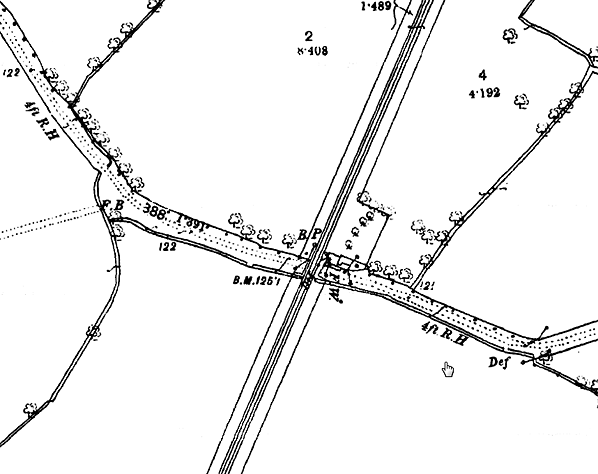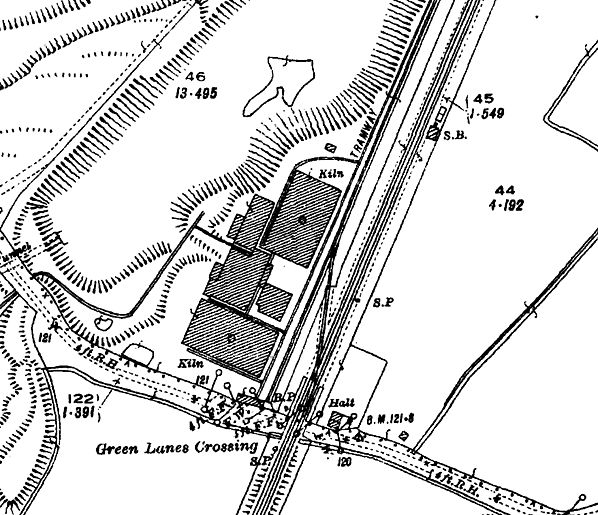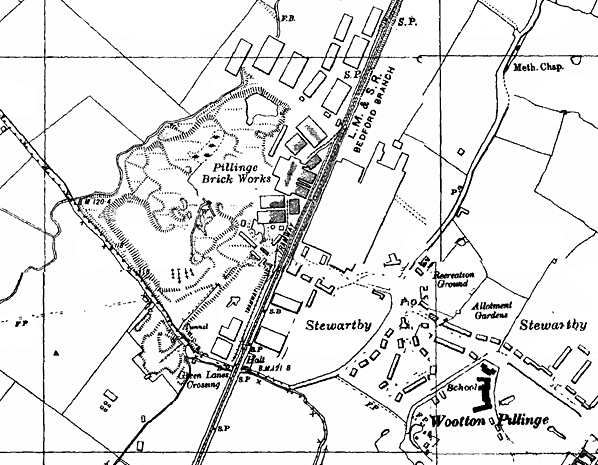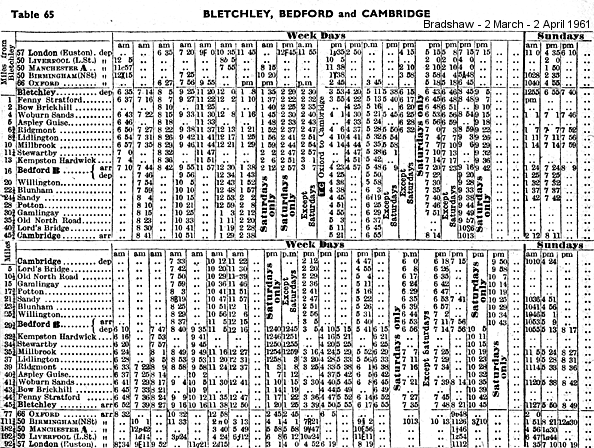
Station Name: STEWARTBY Station still open but included for completeness [Source: Nick Catford]
Stewartby Station Gallery 1 Early 1960s - March 1981 3.jpg) When the Wootton Pillinge Brick Company opened their works it was on the west side of the line but as production increased the works expanded with the railway running through the middle of the huge industrial site. The works is approaching its peak production in this view looking north-east from the level crossing c early 1960s. The platforms were raised to standard height a few years earlier when the push-and-pull steam service was replaced with DMUs.
Photo from John Mann collection  
1886 1:2,500 OS map shows the Green Lanes crossing before the arrival of the halt or the brickworks. There is a crossing keeper's cottage to the east of the crossing.
 1925 1:2,500 OS map shows the halt with two short platforms and no buildings. The crossing keeper's cottage, seen to the east of the level crossing, has been replaced with a new building by the LNWR. Wootton Pillinge signal box is seen to the north of the halt. This controlled access to the siding running into the Wootton Pillinge brickworks which had developed on the west side of the line.
 1938 1:10,560 OS map. By this date the works had expanded to the north and east. All the original buildings of the Wootton Pilling brickworks have been demolished. With the expansion of the works the signal box closed and was replaced with a new box at Forder's Sidings which is off the map to the north. The new 'garden village' of Stewartby is shown between the old Wootton Pillinge village and the railway line. The village housing and town community centre was designed by the noted neo-Georgian architect, Sir Albert Richardson, with each house deliberately placed at an angle to its neighbour. Click here to see a high resolution map of Stewartby brickworks and village in 1960.
Stewartby station looking north-east in September 1967. The up platform is well lit with oil lamps placed at regular intervals; the down platform was not quite so well lit with only two lamps - there were four a few years earlier. The brick kilns are seen behind the down platform. There was a narrow gauge tramway operating on overhead electrification running in front of the kilns. This lasted until about 1960 and all evidence of it had been removed by 1965. By this date the kilns were loaded using forklift trucks.
Copyright photo by H C Casserley Stewartby station up platform seen from an approaching Cambridge-bound train in December 1967, a week before the Oxford - Cambridge service was withdrawn. The lever frame is seen bottom right between the crossing and the keeper's hut. Note the small ticket window to the left of the hut door. Note also a small section of the low platform in front of the hut; this was retained to avoid having to rebuild the hut when the platforms were raised. The original platform consisted of old sleepers but these were replaced with concrete paving slabs in the 1930s.
Photo by Nick Catford 4.jpg) Stewartby station looking south-west c late 1960s. The platform lighting has been considerably reduced with only one oil lamp remaining on each platform. The crossing keeper's cottage is seen behind the platform. This is not the original cottage but a late nineteenth century replacement. It is very plain compared with other crossing keepers’ cottages on the line and follows the LNWR's standard design for company employees. A conveyor belt is seen crossing the line to the south of the station. This dates from the 1960s and runs to the new clay pits that were excavated at this time to the south of the station.
Photo from John Mann collection 5.jpg)
Green Lane level crossing c late 1960s. The crossing keeper stands by his hut. The keeper was also responsible for selling tickets until 15 July 1968 when the halt became unstaffed. Note the timber waiting shelter on the opposite side of the crossing.
Photo from John Mann collection 6.jpg)
Brick workers are seen arriving at Stewartby station to wait for the next train to Bedford St Johns c late 1960s. At this time there were 17 trains a day. There was an early morning (05.48) night shift workers’ train that ran non-stop between Bletchley and Stewartby.
Photo from John Mann collection
10.jpg)
18.jpg)
Stewartby down platform in May 1973. Although Stewartby was officially upgraded from a halt to a station in 1928 it was in name only, and little else changed. In BR days the low platforms were not raised until 1959 and one BR (LMR) maroon running-in board was installed on each platform. For some obscure reason, the platform lighting was gradually reduced and although the four wooden posts that once supported oil lamps are still seen there is no platform lighting at all at this time. Perhaps this was a deliberate ploy from British Rail to discourage passengers as the railway was under threat of closure between 1972 - 1975 at the same time as the brickworks reached peak production level; on the other hand, the lamp cases could readily be taken from the hooks on the posts, and at any time might have been kept safely in the crossing keeper’s hut, unless ‘light-fingered’ passengers had
taken them as souvenirs. Photo by Alan Young
19.jpg) Stewartby station looking south-west from a Bedford DMU in May 1973. The conveyor belt in the background is the only evidence of the heavy industry that would be seen in the opposite direction.
Photo by Alan Young 20.jpg)
Stewartby crossing keeper's hut and lever frame in February 1977. Part of the earlier low platform is seen in front of the hut. The 'paytrain' poster on the notice board indicates that the station is now unstaffed. The crossing keeper sold tickets from the hut until 15 July 1968.
Photo by Alan Young 21.jpg)
Stewartby station looking north-east along the Bletchley platform in February 1977.
Photo by Alan Young 22.jpg)
Stewartby looking south-west in March 1981. The station took on British Rail's Corporate Identity in 1977. At Stewartby that meant new white and black running-in boards and the reinstatement of two of the oil lamps on the original posts. This was one of the last BR stations in England to retain oil lighting.
Photo by Alan Young 23.jpg) Stewartby station looking north-east from the up platform on a bleak, wet day in March 1981. By this date brick production at Stewartby was in decline. Three years later the London Brick Company was acquired by Hanson plc.
Photo by Alan Young Click here for Stewartby Station Gallery 2 1984 - 2014
|
 In 1926 the LBC began to build a ‘garden village’ for its employees at Wootton Pillinge; the village was to be named Stewartby after Sir Halley Stewart, the former Liberal Parliamentary candidate for Peterborough and first chairman of the Wootton Pillinge Brick Company. Following the building of the village, Wootton Pillinge ceased to be a halt from 1 January 1928 and the LMS renamed the station Stewartby on 8 July 1935. The original sleeper platforms were replaced with concrete paving before any of the other halts on the line were rebuilt. A timber waiting shelter was provided at the south end of the down platform, adjacent to the crossing. Tickets were sold by the crossing keeper and a small ticket window was installed in the keeper’s hut. As the Wootton Pillinge signal box had closed a new external lever frame was installed by the LMS adjacent to the crossing keeper’s hut in the early 1930s. The Stewartby brickworks was connected to the Marston Vale line via a 2 ft 11 in narrow gauge railway operating on overhead electrification. This is believed to have been installed in the 1930s and it lasted until 1960.
In 1926 the LBC began to build a ‘garden village’ for its employees at Wootton Pillinge; the village was to be named Stewartby after Sir Halley Stewart, the former Liberal Parliamentary candidate for Peterborough and first chairman of the Wootton Pillinge Brick Company. Following the building of the village, Wootton Pillinge ceased to be a halt from 1 January 1928 and the LMS renamed the station Stewartby on 8 July 1935. The original sleeper platforms were replaced with concrete paving before any of the other halts on the line were rebuilt. A timber waiting shelter was provided at the south end of the down platform, adjacent to the crossing. Tickets were sold by the crossing keeper and a small ticket window was installed in the keeper’s hut. As the Wootton Pillinge signal box had closed a new external lever frame was installed by the LMS adjacent to the crossing keeper’s hut in the early 1930s. The Stewartby brickworks was connected to the Marston Vale line via a 2 ft 11 in narrow gauge railway operating on overhead electrification. This is believed to have been installed in the 1930s and it lasted until 1960.  Intermediate stations from Bletchley were Fenny Stratford, Ridgmont, Lidlington and Manston (later renamed Millbrook). The line opened on 18 November 1846; the line from Oxford - Bletchley opened on 20 May 1851. The final link from Bedford to Cambridge opened on 7 July 1862 provided an important cross-country line between Oxford and Cambridge, forming one of the few east-west routes with the capability of reaching the east coast ports. Most services, however, ran from Oxford to Bletchley and from Bletchley to Cambridge.
Intermediate stations from Bletchley were Fenny Stratford, Ridgmont, Lidlington and Manston (later renamed Millbrook). The line opened on 18 November 1846; the line from Oxford - Bletchley opened on 20 May 1851. The final link from Bedford to Cambridge opened on 7 July 1862 provided an important cross-country line between Oxford and Cambridge, forming one of the few east-west routes with the capability of reaching the east coast ports. Most services, however, ran from Oxford to Bletchley and from Bletchley to Cambridge.

 The Bedford - Bletchley (Marston Vale) Line is one of the two remaining sections of the former Varsity Line (Oxford - Cambridge) still in passenger use. In the 2011 Autumn Statement the Chancellor of the Exchequer, George Osborne, announced the allocation of £270 million for the East West Rail Consortium to reinstate the Oxford – Bletchley – Bedford section of the Varsity Line. The service will link the Marston Vale Line (calling at Bedford, Lidlington, Woburn Sands and Bletchley only) to Winslow, Bicester Town, Oxford and Reading. The Consortium hopes later to reopen the Bedford — Cambridge section, for which a new route may be required, possibly involving the use of the East Coast main line south from Sandy then the Hitchin – Cambridge line, with a new north-to-east chord just north of Hitchin.
The Bedford - Bletchley (Marston Vale) Line is one of the two remaining sections of the former Varsity Line (Oxford - Cambridge) still in passenger use. In the 2011 Autumn Statement the Chancellor of the Exchequer, George Osborne, announced the allocation of £270 million for the East West Rail Consortium to reinstate the Oxford – Bletchley – Bedford section of the Varsity Line. The service will link the Marston Vale Line (calling at Bedford, Lidlington, Woburn Sands and Bletchley only) to Winslow, Bicester Town, Oxford and Reading. The Consortium hopes later to reopen the Bedford — Cambridge section, for which a new route may be required, possibly involving the use of the East Coast main line south from Sandy then the Hitchin – Cambridge line, with a new north-to-east chord just north of Hitchin.2.jpg)
1.jpg)

 Home Page
Home Page